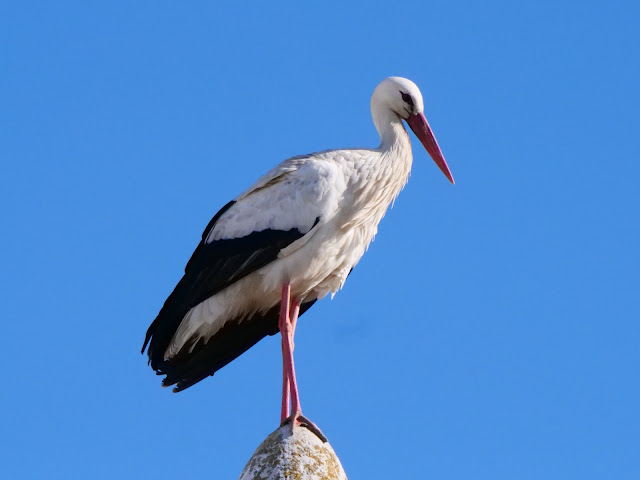13th February - Ria Formosa and Faro
There are many companies that offer boat trips around the extensive lagoons of Faro known as Ria Formosa. Depending on the tide it is possible to see quite a range of different waders and sea birds and in some cases get fairly close to allow photographs to be taken. We saw Spoonbill, Whimbrel, Kentish Plover, Ringed Plover, Little Egret, Caspian Tern, Dunlin, Grey Plover, Great Cormorant, Oystercatcher, Mediterranean Gull, Sandwich Tern and Lesser Black-backed Gull.
 |
| Dunlin |
 |
| Spoonbill |
White Storks nest on top of the houses in an around Faro. It is also possible to walk westwards along the harbour by the railway line where there is an area of scrub together with salt pans that contain more birds such as Black-winged Stilt, Crested Lark, Stonechat and Chiffchaff.
 |
| White Stork |
14th February - Fonte da Benemola and Faro
Fonte da Benemola is about a 1 hour drive north of Faro and turned out to be a great place to see butterflies and flowers as well as birds. We walked for about four hours following the river and upon onto the top which is a mixture of scrubland and also areas that were formerly farmland including almond orchards. Butterflies included Spanish Festoon, Green Hairstreak (which were the most plentiful), Speckled Wood, Small Heath, Large White, Holly Blue and Brimstone. Amongst the flowers the Friar's Cowl and Paperwhite Narcissus were particularly attractive. Blue Rock Thrush also occurs here.
 |
| Spanish Festoon |
Later back at Faro a walk along the waterfront resulted in Hoopoe, Serin, Sardinian Warbler, Meadow Pipit, Black-winged Stilt and Greater Flamingo.
 |
| Hoopoe |
15th February - Ria de Alvor and Sagres Peninsular
On day 3 we headed west for our longest trip taking in firstly Ria de Alvor where there is an impressive boardwalk that allow you to walk across the lagoons and by the beach. Here we saw Corn Buntings, Linnets and Little Stints.
 |
| Little Stint |
The Sagres Peninsular is the most south-westerly part of Europe and is excellent for flowers and coastal birds. Here we say Gannets, Black Redstart, Sonechat, Sardinian Warbler and Kestrel as well as some really exquisite flowers. On the drive back to Faro we saw a Black-shouldered Kite by the side of the A22 motorway.
 |
| Stonechat |
16th February - Castro Marim and Sapal de-Venta Moinhois
These two sites are east of Faro on the Spanish border. Castro Marim is an extensive lagoon area with large numbers of Gulls and Flamingos together with Corn Buntings. We were also lucky enough to see a single Cattle Egret here. Personally I found Sapal de-Venta Moinhois more interesting with a greater diversity of habitat and hence more species of birds. We had good views of a Short-toed Eagle and brief sightings of a Southern Grey Shrike. Also Buzzard, Marsh Harrier, Red-legged Partridge and Zitting Cisticola and several Black-winged Stilts.
 |
| Marsh Harrier |
17th February - Ria Formosa and Faro
In the morning the scrub area near Faro produced a Wryneck as well as the usual birds. In the afternoon we took another boat trip from Faro, this time a 3 hour excursion out to the edge of the lagoon where it meets the sea. This turned out to be a good place to see Mediterranean Gulls and also Bar-tailed Godwits.
 |
| Wryneck |
18th February - Ludo
The final day was spent at the Ludo Nature Park which is a wonderful area just to the west of faro near the airport. Here we saw several Hoopoes and Azure-winged Magpies, the latter proving very difficult to photograph. Also a Water Rail that came out of the reeds long enough to have its picture taken and a Little Grebe in summer plumage. Plus Spoonbill, Greater Flamingo, Whimbrel and Black-winged Stilt as always together with Greenshank, Redshank, Dunlin, Turnstone, Ringed Plover and a Black-shouldered Kite.
 |
| Water Rail |


























